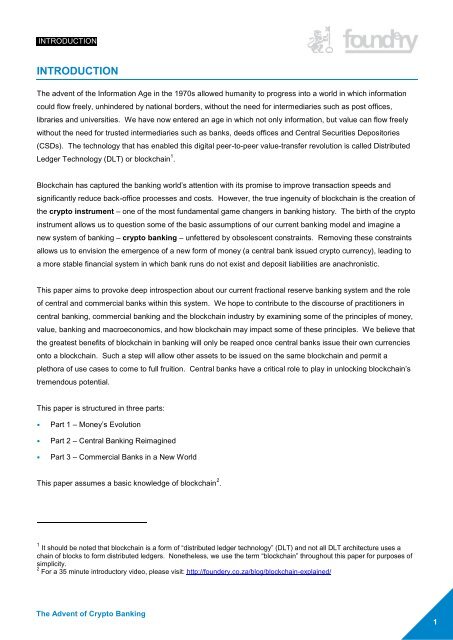The Advent of Crypto Banking
The_Advent_of_Crypto_Banking
The_Advent_of_Crypto_Banking
Create successful ePaper yourself
Turn your PDF publications into a flip-book with our unique Google optimized e-Paper software.
INTRODUCTION<br />
INTRODUCTION<br />
<strong>The</strong> advent <strong>of</strong> the Information Age in the 1970s allowed humanity to progress into a world in which information<br />
could flow freely, unhindered by national borders, without the need for intermediaries such as post <strong>of</strong>fices,<br />
libraries and universities. We have now entered an age in which not only information, but value can flow freely<br />
without the need for trusted intermediaries such as banks, deeds <strong>of</strong>fices and Central Securities Depositories<br />
(CSDs). <strong>The</strong> technology that has enabled this digital peer-to-peer value-transfer revolution is called Distributed<br />
Ledger Technology (DLT) or blockchain 1 .<br />
Blockchain has captured the banking world’s attention with its promise to improve transaction speeds and<br />
significantly reduce back-<strong>of</strong>fice processes and costs. However, the true ingenuity <strong>of</strong> blockchain is the creation <strong>of</strong><br />
the crypto instrument – one <strong>of</strong> the most fundamental game changers in banking history. <strong>The</strong> birth <strong>of</strong> the crypto<br />
instrument allows us to question some <strong>of</strong> the basic assumptions <strong>of</strong> our current banking model and imagine a<br />
new system <strong>of</strong> banking – crypto banking – unfettered by obsolescent constraints. Removing these constraints<br />
allows us to envision the emergence <strong>of</strong> a new form <strong>of</strong> money (a central bank issued crypto currency), leading to<br />
a more stable financial system in which bank runs do not exist and deposit liabilities are anachronistic.<br />
This paper aims to provoke deep introspection about our current fractional reserve banking system and the role<br />
<strong>of</strong> central and commercial banks within this system. We hope to contribute to the discourse <strong>of</strong> practitioners in<br />
central banking, commercial banking and the blockchain industry by examining some <strong>of</strong> the principles <strong>of</strong> money,<br />
value, banking and macroeconomics, and how blockchain may impact some <strong>of</strong> these principles. We believe that<br />
the greatest benefits <strong>of</strong> blockchain in banking will only be reaped once central banks issue their own currencies<br />
onto a blockchain. Such a step will allow other assets to be issued on the same blockchain and permit a<br />
plethora <strong>of</strong> use cases to come to full fruition. Central banks have a critical role to play in unlocking blockchain’s<br />
tremendous potential.<br />
This paper is structured in three parts:<br />
• Part 1 – Money’s Evolution<br />
• Part 2 – Central <strong>Banking</strong> Reimagined<br />
• Part 3 – Commercial Banks in a New World<br />
This paper assumes a basic knowledge <strong>of</strong> blockchain 2 .<br />
1 It should be noted that blockchain is a form <strong>of</strong> “distributed ledger technology” (DLT) and not all DLT architecture uses a<br />
chain <strong>of</strong> blocks to form distributed ledgers. Nonetheless, we use the term “blockchain” throughout this paper for purposes <strong>of</strong><br />
simplicity.<br />
2 For a 35 minute introductory video, please visit: http://foundery.co.za/blog/blockchain-explained/<br />
<strong>The</strong> <strong>Advent</strong> <strong>of</strong> <strong>Crypto</strong> <strong>Banking</strong><br />
1


